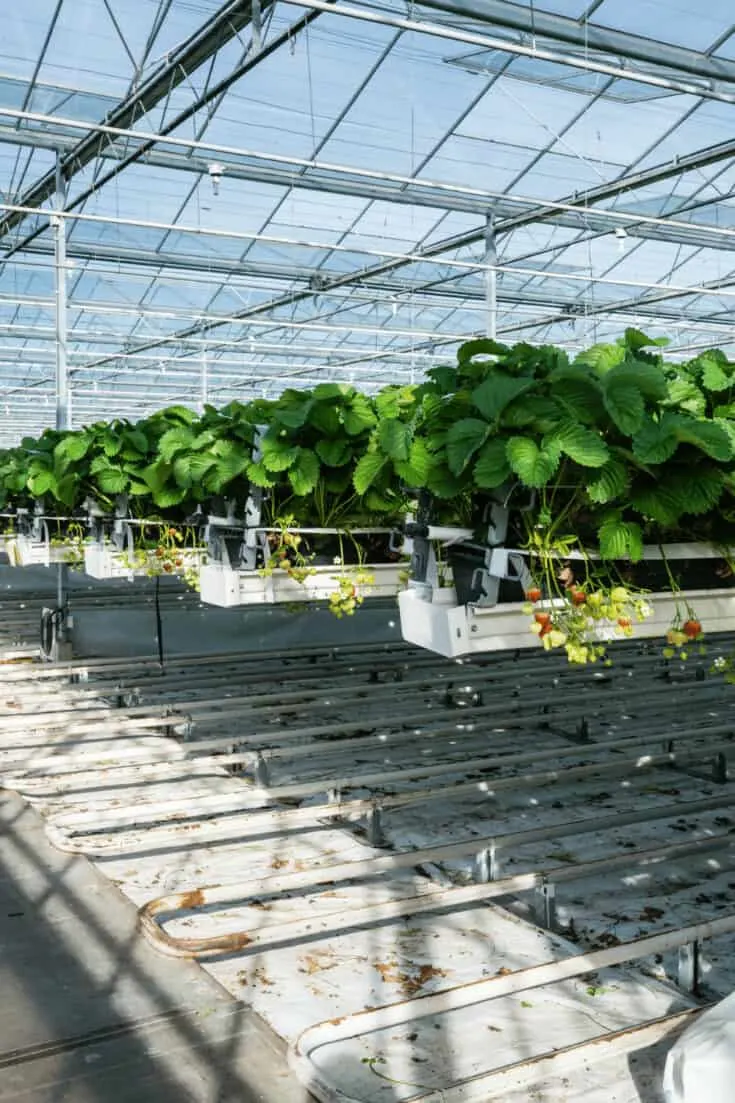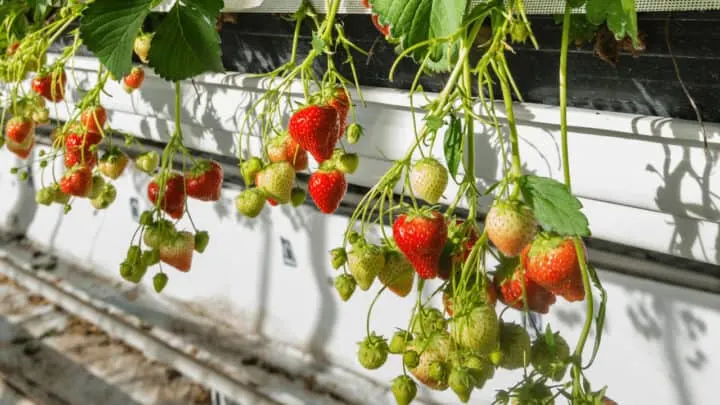Have you heard of hydroponic growing? This is a type of gardening that does not use soil, but rather the plants use nutrient-enriched water as a growing medium.
Hydroponics is a particularly common method of growing tomatoes, herbs, and berries, too- like strawberries!
What hydroponics solution works best for strawberries?
The best hydroponic system for strawberries is an ebb and flow system, that allows for the plants to fully dry out between watering. Strawberries require an ample amount of nitrogen, phosphorous, and potassium in their hydroponic water solution to thrive, as well as oxygen, hydrogen, and carbon that the plant gleans from the water and air.

What Hydroponics Solution Works Best for Strawberries?
Table of Contents
Want to learn more about growing strawberries hydroponically? Keep reading!
Hydroponic Strawberry Plants
There is some specialized equipment and supplies that you will need if you intend to plant hydroponic strawberries– so, what are the advantages of growing strawberries in this way?
The reasons why gardeners choose hydroponic systems include the following advantages.
- Hydroponic systems do not utilize soil, so it is cleaner and easier to maintain.
- Hydroponic systems do not attract soil-based pests, like beetles.
- Hydroponic systems are less vulnerable to flying pests and insects.
- Hydroponic systems are water-efficient, and you reuse and recirculate water.
- Hydroponic systems can be set up vertically to conserve and optimize space.
- Hydroponic systems provide a viable option for indoor gardening that yields good results.
Another advantage of the hydroponic systems comes at harvest time- it is easier to harvest and gather your strawberries from your hydroponic system than it is from kneeling down in the soil!
Now that you know the advantages and perks of growing strawberries in this manner, keep reading to learn more about the hydroponic process and the nutrients you need for a good yield at harvest time.

An Ebb and Flow System is the best Hydroponics system for strawberries as it delivers the best yield
Hydroponic Strawberry Solution
To start out, you have a couple of options when it comes to beginning your strawberry plants.
Are you going to germinate your own seeds, or are you going to use strawberry plant seedlings, instead?
It can take years to establish strawberry seeds and prepare them for fruit, so you may want to jump in with young strawberry plants from a local nursery.
Directly plant your strawberry plants in the hydroponic system using a solution that contains these nutrients.
- Nitrogen helps the plant grow and develop foliage.
- Phosphorous contributes to a healthy root system and lots of buds.
- Potassium is a required nutrient for photosynthesis.
Additionally, it is recommended that you enrich the water solution with secondary and micronutrients, as suggested by your garden retailer or professional.
Some of the suggestions recommended by master gardeners include these.
- Calcium
- Magnesium
- Sulfur
Your strawberries will get ample hydrogen, oxygen, and carbon- also essential- from the water and the air.
While not part of the natural hydroponic nutrients, you will need to supplement your solution with these, too.
- Manganese
- Copper
- Iron
- Chlorine
- Zinc
Since these elements are commonly derived from the soil, you may need to purchase supplements for your hydroponic water if you want hardy strawberry plants.
Together, these nutrients and minerals work in tandem to create a strong, healthy plant.

Strawberries growing in an NFT System
Best Hydroponic System for Strawberries
There are several different types of hydroponic systems that you can use when growing, but know that each method is more suited to specific crops.
In terms of strawberries, an ebb and flow system seems to yield the best results.
Ebb and flow systems involve flooding the plants- in this instance, strawberries- with nutrient-enhanced water.
After flooding the plants, you give them time to completely dry out.
When a plant dries out, it is able to fully absorb the nutrients and become hardy. This is a common approach for cucumbers and tomatoes but also works best with strawberries.
Consider, also, other environmental factors for the best results when growing strawberries.

Vertical growing strawberries in a hydroponics tower
Temperature
Strawberries do best in temperatures around 65-80 degrees Fahrenheit.
Light
Ideally, your hydroponic strawberries should get 8-12 hours of light per day. Strawberries that are not grown outside or in greenhouses will require some supplemental light sources, otherwise, you risk their hardiness.
pH Levels
Try not to add plain tap water directly to the system without filtering and testing it.
This may mess up the nutritional balance of your hydroponic solution, resulting in overfeeding or underfeeding your strawberry plants.
Invest in a pH meter to make it easy to test the water often. Ideally, you want to aim for a pH of around 6.0, when possible.
Pruning
Strawberries like to be pruned to grow hardy. Prune away the runners, which are leafless, leggy stems that are also great for the propagation of new plants, too.
Frequently Asked Questions About What Hydroponics Solution Works Best for Strawberries
What is hydroponics?
Hydroponics refers to a method of gardening that does not use soil, but rather uses a water solution for the plant’s roots. This is a popular growing style for tomatoes, herbs, and berries.
What nutrients do hydroponic strawberries need?
Strawberries need nitrogen, phosphorous, and potassium in their hydroponic grow solution.
Can strawberries be grown hydroponically?
Strawberries can be grown hydroponically with great success, as can many other types of berries with similar results and a healthy yield.
How do you grow strawberries indoors?
Grow your strawberries indoors by starting to germinate seeds and establishing some roots. Make sure that you keep the seeds moist and near a source of natural sunlight. Transfer the seedlings to the soil, or your hydroponic grow system.
How do you start a strawberry properly?
If you are using a seedling, make sure that you keep your plant and its soil moist- and spritz with a bit of water, as needed to prevent it from drying out. If you are germinating your own seeds, it takes up to a month to see roots and to transplant to soil or hydroponic solution, depending on how you choose to grow.
What is the best type of soil for strawberries?
A loamy mix consisting of clay, sand, and organic matter makes a good growing medium for strawberries. If you prefer not to grow your strawberries in soil, you may choose to grow your berries hydroponically instead, using water and no soil.
When to start strawberry seeds?
Start strawberry seeds indoors about six to eight weeks before the last frost. It makes sense to check a hardiness zone calendar to determine the best time to plant as well as the best kinds of strawberries for your geographic region and climate.
Conclusion About What Hydroponics Solution Works Best for Strawberries
Planning to grow strawberries?
Hydroponic growing is efficient and clean- and an easy way to glean an excellent harvest.
Use these grow tips and suggestions for the best strawberry solution and methods for your hydroponic system!

Daniel has been a plant enthusiast for over 20 years. He owns hundreds of houseplants and prepares for the chili growing seasons yearly with great anticipation. His favorite plants are plant species in the Araceae family, such as Monstera, Philodendron, and Anthurium. He also loves gardening and is growing hot peppers, tomatoes, and many more vegetables.


